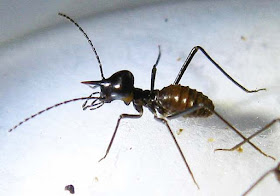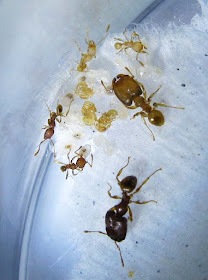Pheidole genus is the largest of ant's genera. This genus is typify by a major worker caste with a disproportionately large head. Until the discovery of several trimorphic species in the Americas, this had been the definition of this genus.
In most species there is only a single major worker size but some species has several sizes of major workers. But
here in this blog, this author has encountered a trimorphic species with three different workers morphological expression - a major worker caste, a medium worker caste and a minor worker caste (see
sp24 below).
Trimorphic species of the Pheidole genus are rare with only seven (according to some documentations) documented species, all of them in the Americas. All of these seven has two major workers expression and a minor worker expression.
Here then in this blog is
the only documented species with a medium worker expression aside from the common major and minor worker expression.
The first brood (the founding brood) of a new
founding queen of Pheidole almost invariably consist of only minor workers. Major normally appear around one month or more after the first eclosed workers have started foraging. The first brood of most Pheidole species are small numbering not more than ten minor workers in the first month of foraging. In some species these may be as few as only five. This is a primary cost of being fully claustral. In some species of ants this is mitigated by the queen being disproportionately larger than her workers, not
too different from a female Kangaroo and her newly born. In species such as Pheidologeton, the large queen is not only able to raise a first brood of minor workers ranging in numbers from thirty to more than fifty, but also in the first founding brood are two or more small major workers. I have also encountered (when many years back I was working in the north) a species (not documented) with a queen larger than Pheidologeton diversus but with workers of less than two millimeters. The founding brood numbered more than a hundred tiny workers.
This is not to say that semi claustral queens raise a larger founding brood, they seldom do. In fact most of them raise a fairly small founding brood seldom numbering more than five workers that are also nominally smaller than a regular size minor worker of their matured nest. The advantage to being semi claustral is that the queen do not need to be in a rush to raise a brood of workers as they (the queens) are fairly capable of defense and taking down prey. Most semi claustral queens are equipped with a sting for defense and also to take down small prey items. Even those without an effective sting such as in Polyrhachis and some species of Camponotus with semi claustral queens, the queens are not without a chemical defense system. One common feature of semi claustral queens is that they are normally about the same (or just slightly larger) than their workers and are just as agile and effective a lone hunter-forager.
In Pheidole once foraging begins, major workers development take place in earnest and in many to most species, a month or so later the first major worker will eclosed. The appearance of major workers is a crucial development in Pheidole as lacking a sting and an effective chemical defense, the main nest defense against other ants (especially those of the same species/genus) depended heavily upon the major workers. In most species the major workers also played a major role in food acquisition.
In many species the major workers take on the role of semi repletes in the earlier part of their life span while in a few this role appears to be more pronounced with a greater gaster enlargement such as in the first species (sp01) recorded below.
Pheidole sp01
This very common species, the most commonly found species in this location, is small, the gyne measuring not more than 6 mm. Once sealing herself in her new nest the gyne will start laying eggs with 24 hours. Though classed as a fully clustral species the founding will move her whole nest (before any of her workers eclosed) should it become exposed, dried out too much or threatened by some activities of potential predator or competing species in her proximity.
A gyne with her first clutch of eggs.
The eggs typically hatch in 6 days.







A callow, a matured worker and some brood
Two major workers.
Major workers of some small Pheidole species function as repletes in their young life serving as food storage container just as honey pot ants are though not as extreme.
Major workers of Pheidole ant serving their time as repletes.
A major worker of Pheidole ant. In this species the major worker spent the major part of its adulthood as a food replete store. While in many advance ants species a large food find may find most of the younger workers with distended gaster, these however are temporary and these workers do not retain the distended gaster over long periods unlike with the replete workers, nor do the gaster extend to more than three times its depleted size. In some species the distention in the gaster are not as large proportionately. This species has one of the largest gaster extension in the repletes which may be partially contributory to its success as a predominant species found everywhere in this region.
The minor workers harvesting pollen from hibicus flowers
Pheidole sp02.

This once very commonly found pest species is all but wipe out by indiscriminate use of modern pesticides in most urban and suburban areas. They can still be commonly found in rural areas especially in orchards and plantation land.
Pheidole sp03.
A worker grooming a callow.
Some callows (newly eclosed from the pupae stage).
The callow of a major worker.
The shy gyne.
Pheidole sp05.
A 1.5 mm
Pheidole sp7 major. The minor worker is only 1.2 mm making this the smallest size species I have come across to date.
Pheidole sp10.
Pheidole sp9.
A species that has the major workers serving as semi repletes.
Pheidole sp11
Pheidole sp12
Pheidole sp17
Pheidole sp(27)
Pheidole longipes
A large species with long limbs.
Pheidole sp14.
Another species that has the major workers serving as semi repletes.
Pheidole sp35.
Minor and major workers of Pheidole sp35.
Minor worker of Pheidole sp35.
Another species that has the major workers serving as semi repletes. In this species the function of the major workers as semi repletes is equal to those in some Oligomyrmex species which has semi repletes major workers. In the major workers the frontal portion (the area above the frontal lobes which is absent in Pheidole ants) is more elevated presenting a raised plateau in the frontal region which may serve to block the entrance holes to the nest or as an obstacle to invaders in the tunnels.
Pheidole sp15.
An above average size species this species have long propodeal spines.
Pheidole sp16.
An average size species of Pheidole with major at around 5 millimeters and minor at around 3 millimeters.
Major worker Pheidole sp.
Minor worker Pheidole sp.
Pheidole sp19
Another small species the majors are around 3.3 mm and the minor are around 2.3 mm.
Pheidole sp20
Pheidole sp18
Pheidole sp37
Pheidole sp22
Major and minor workers of Pheidole sp(22). In this species the head of workers are more oval, especially so in the minor workers making the appearance more similar to those of the smaller (those with minor workers of 2 millimeters and lesser) species.
Major and minor workers of Pheidole sp(22).
Minor workers of Pheidole sp(22).
Pheidole sp23
Minor worker of Pheidole sp23. In this species the major workers also take on the role as repletes in the early part of their life span, but the enlargement of the gasters are not as pronounced as in sp14.
Minor worker of Pheidole sp23.
Pheidole sp30
Another average size Pheidole ant, this species has major at around 5 mm and minor at around 3 mm. Marginally smaller than sp(23) above, in this species the propodeal spines of the majors are tiny.
Minor worker of Pheidole sp(30).
Major worker of Pheidole ant.
Pheidole 32
Major worker (3.4 millimeters) and minor workers (2.8 millmeters)
Pheidoles sp33
Minor and major worker Pheidole sp
Median, minor and major worker of a rare trimorphic Pheidole species.
Pheidole sp25
Pheidole sp27
Pheidole sp28
In this species the major workers also take on the role as semi repletes in the early part of their life span, but the enlargement of the gasters are not as pronounced.
Pheidole sp29
Minor and major workers of Pheidole ants.
Major worker of Pheidole sp29 that eclosed not too many days ago and still to haven't darkened to the final coloration.
Minor workers of Pheidole sp29. Workers color are a light golden brown.
See also:
Taxonomy:No rank: cellular organisms 131567
Superkingdom (Domain): Eukaryota 2759
No rank: Opisthokonta 33154
Kingdom: Metazoa 33208
No rank: Eumetazoa 6072
No rank (Subkingdom): Bilateria 33213
No rank (Branch): Protostomia 33317
No rank (Infrakingdom): Ecdysozoa
No rank (Superphylum): Panarthropoda 88770
Phylum: Arthropoda 6656
No rank (Subphylum): Mandibulata 197563
No rank: Pancrustacea 197562
Subphylum (Epiclass): Hexapoda 6960
Class: Insecta 50557
No rank (Subclass): Dicondylia 85512
Subclass (Infraclass): Pterygota 7496
Infraclass: Neoptera 33340
Cohort: Holometabola
Order: Hymenoptera 7399
Suborder Apocrita 7400
Infraorder: Aculeata 7434
Superfamily: Formicoidea
Family: Formicidae 36668
Subfamily: Myrmicinae 34695
Tribe: Pheidolini 144015
Genus: Pheidole 190769








































































































































